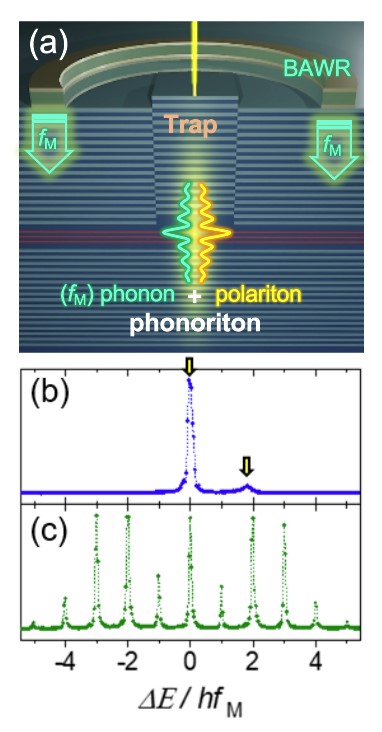This discovery opens a novel way to coherently convert information between optical and microwave domains, bringing potential benefits to the fields of photonics, optomechanics and optical communication technologies.
The research team's work draws inspiration from an everyday phenomenon: the transfer of energy between two coupled oscillators, such as, for instance, two pendulums connected by a spring [1]. Under specific coupling conditions, known as the strong-coupling (SC) regime, energy continuously oscillates between the two pendulums, which are no longer independent, as their frequencies and decay rates are not those of the uncoupled ones. The oscillators can also be photonic or electronic quantum states: the SC regime, in this case, is fundamental for quantum state control and swapping.
In the above example, the two pendulums are assumed to have the same frequency, i.e., in resonance. However, hybrid quantum systems require coherent information transfer between oscillators with largely dissimilar frequencies. Here, one important example is in networks of quantum computers. While the most promising quantum computers operate with microwave qubits (i.e., at few GHz), quantum information is efficiently transferred using near infrared photons (100ds THz). One then needs a bidirectional and coherent transfer of quantum information between these domains. The direct conversion between microwave qubits and photons is, in many cases, very inefficient. Here, one alternative is to mediate the conversion by a third particle, which can efficiently couple to both the microwave qubits and photons. A good candidate are GHz vibrations of the lattice (phonon).
The theoretical groundwork for the SC between light and phonons was laid in 1982 by Keldysh and Ivanov [2], who predicted that semiconductor crystals can mix photons and phonons via another quasi-particle: the exciton-polariton (in the following: polariton). Polaritons emerge from the strong coupling between photons and excitons. When a phonon comes into play, it can couple two polariton oscillators with frequencies differing by exactly the frequency of the phonon. If the coupling is large enough, i.e., in the SC regime, it leads to the formation of a new quasi-particle – the phonoriton, which is a mixture of an exciton, a photon and a phonon. Due to stringent experimental requirements for phonoriton emergence, however, there have been very few reports on phonoriton formation [3]. Besides the scientific importance of the discovery of this novel fundamental semiconductor excitation, the phonoriton can be a new promising intermediary for the coherent microwave-to-optical frequency conversion.
In their work, Kuznetsov et al. created polaritons in a patterned microcavity resonator. Micrometer-sized thicker regions within the microcavity act as hybrid traps both for 370 THz polaritons and 5 to 20 GHz phonons. The trapping enhanced manifold the interaction between the two particles, which is an important requirement for phonoriton formation. By optically injecting more polaritons into the trap, the team created two polariton condensates, which are characterized by a very bright and spectrally narrow (sub-GHz) emission line. Unlike conventional lasers, polaritons have strong interparticle interactions, warranting the name of ’quantum fluids’ of light. Due to these interactions, the energy splitting between the two light fluids can be precisely tuned by controlling their densities using an external laser. When the energy splitting matches the phonon energy, the two polariton fluids synchronize. The synchronization is due to a combination of non-linear polariton-polariton interactions and the efficient transfer of polaritons between the light fluids mediated by the absorption and emission of phonons. It is found that the phonon-induced coupling between polariton states exceeds their decay rate, marking the emergence of the phonoriton.
The authors then used a piezoelectric transducer, fabricated on top of the microcavity and around the trap, to control the device with microwaves and inject 7 GHz phonons into the trap [4]. In the presence of the injected phonons, the phonoriton spectrum transforms into a comb of narrow resonances (or phonon sidebands), as shown in Fig. 1(c). The sidebands to the left (right) of the central peak correspond to the coherent emission (absorption) of phonons, thus demonstrating the bidirectional microwave-to-optical conversion. Interestingly, and unlike conventional optomechanical systems, where phonons directly interact with photons and the interaction strength depends only on the photon number, here, the interaction scales with both the polariton and phonon populations.
In conclusion, the work of Kuznetsov et al. tailored photonic, electronic and phonon resonances of patterned semiconductor microcavities to demonstrate phonoritons as well as the coherent bidirectional microwave-to-optical conversion in a semiconductor system.


